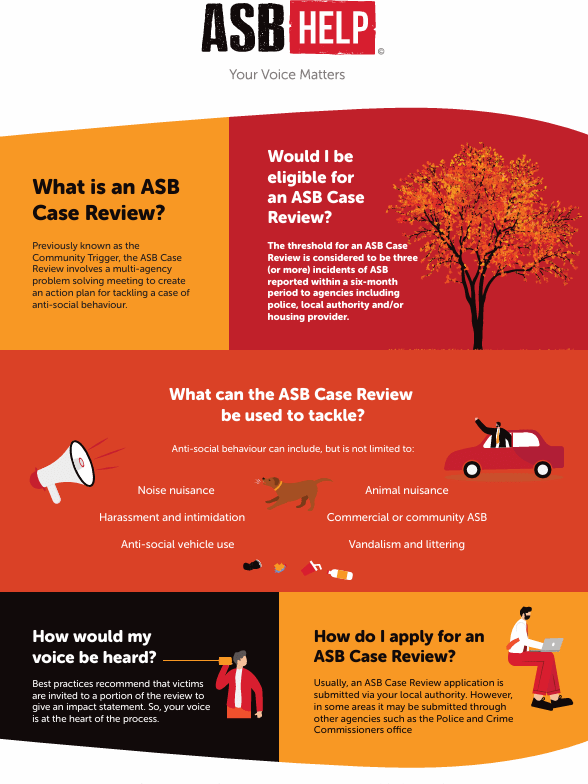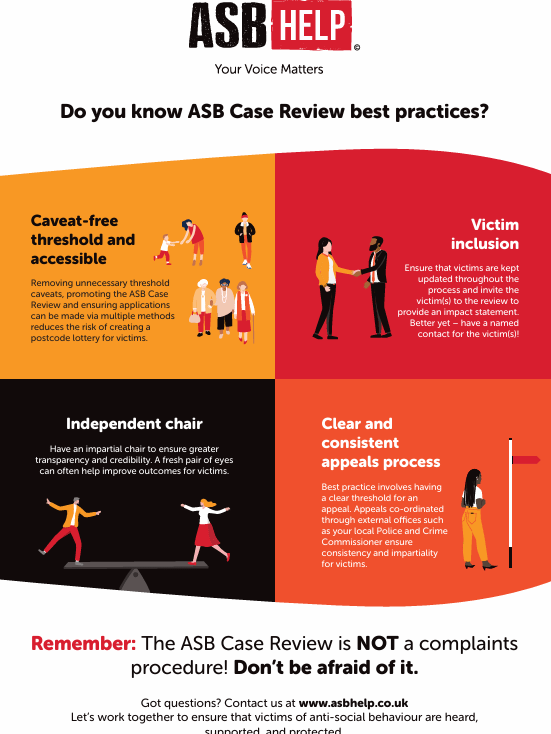What is the ASB Case Review?
The ASB Case Review, formerly known as the Community Trigger, is an effective tool to problem solve anti-social behaviour (ASB) in communities. Introduced into legislation by the ASB Crime and Policing Act 2014, the ASB Case Review provides victims with a voice. Its intended function is to act as a safety net to ensure that all partnership agencies work together to determine the most appropriate solution. It is used where an individual has reported incidents of ASB, and the problem is still ongoing.
The ASB Case Review is a formal process whereby victims of anti-social behaviour (ASB) can apply for an independent review of their case. Each local area has their own arrangements for who is responsible for the ASB Case Review process. Information on this will be detailed on their website. These are most likely to be the local authority, police or the Police and Crime Commissioner.
If the case meets the local threshold (see below), the agencies meet to discuss the case in detail and develop an action plan to tackle the ASB, as well as ensure the relevant support is in place for the victim. Because the ASB Case Review gives victims a voice, all agencies must be familiar with the process to ensure it works effectively.
The ASB Case Review statutory guidance states, “relevant bodies should always consider inviting the victim to attend a section of the case review meeting to help all members of the panel understand the level of harm and impact it has on them.”
It is important to note, the ASB Case Review is NOT a complaints procedure.
What is the threshold?
The advice in the statutory guidance to practitioners is that the threshold is to be defined by the local agencies and should be set to no higher than three incidents of ASB having been reported in the last six months. The persistence of and the harm/potential harm caused by the ASB, as well as the adequacy of the response to the ASB should also be considered if the standard threshold is not met.
The ASB Case Review threshold is automatically met where:
- An application for an ASB case review is made, and
- At least three qualifying complaints (reports of ASB) have been made about the anti-social behaviour to which the application relates. The three reports can be made to either the same organisation or a mixture of reports to either police, local authority or housing, as long as the reports relate to separate/different incidents and the same single report is not made to three different agencies. A good partnership working arrangement should ensure that this information is shared.
For the purposes of the ASB Case Review procedures, the definition of a qualifying complaint under Section 104 of the Act is:
- The complaint is made within one month beginning with the date on which the behaviour is alleged to have occurred; and
- The application for the ASB Case Review is made within six months of the first complaint.
In addition, regard will be given to:
- The persistence of the ASB about which the original complaint was made;
- The harm caused, or the potential for harm to be caused by that behaviour and;
- The adequacy (effectiveness) of the response to that behaviour (it is important to understand that action may well have been taken to tackle the ASB, but the applicant may have an unrealistic expectation of what that action should look like, e.g. the ASB has stopped but the neighbour has not been evicted/sent to prison. In cases like these it is of paramount importance to manage the expectations of the applicant).
The harm, or the potential for harm to be caused to the victim, is an important consideration in determining whether the threshold is met because the more vulnerable will be less resilient to anti-social behaviour. People can be vulnerable for various reasons, and vulnerability or resilience can vary over time depending on personal circumstances and the nature of the anti-social behaviour.
Behaviour which falls below the level of harassment, alarm, or distress, may not meet the threshold, but when assessed on the grounds of potential harm to the victim, the victim’s own vulnerability, the impact of the behaviour may be such that the threshold is considered to be met. This is often referred to as cumulative impact. The decision on whether the threshold for a case review has been met is taken jointly by the responsible authorities.
Key elements of the ASB Case Review
1. Application
- Application processes vary for each local area – usually a form, email or letter to the local council.
- These can come directly from a victim or 3rd party (with victims' consent).
- They may be an individual or a business.
- The application must be acknowledged in accordance with local policy and procedures.
2. Threshold Test
- Once submitted, agencies must decide if the threshold has been met.
- Each local area sets a threshold which must include;
- Frequency of complaints (no higher than 3 but can be lower, reported to the police, local authority or housing association).
- Effectiveness of the response.
- Taking into account the persistence, harm or potential harm of the ASB to the victim.
- If the threshold has been met the applicant is informed that their review will take place in accordance with local policy and procedures.
- If the threshold has not been met the applicant is informed.
- Although the formal procedure will not be invoked if the threshold is not met, this does still provide an opportunity for the relevant bodies to review the case and whether there is more that can be done.
3. Case Review
- Undertaken by:
- Councils
- Police
- Integrated Care Board (ICB)
- Registered providers of Social Housing
- The review encourages a problem-solving approach aimed at dealing with some of the most persistent, complex cases of anti-social behaviour.
- All information relating to the case is shared with the agencies.
- They review what actions have been taken.
- They assess whether there are additional actions which could be applied.
- There should be a consideration to include somebody independent to review the case and action taken, when most agency representatives have been involved.
- The victim should be invited to attend the case review meeting. This helps members understand the impact and level of harm.
4. Outcome
- The applicant is made aware of the outcome of the review.
- Where further action is necessary an action plan is discussed with the applicant along with timescales.
- The ASB Case Review procedure must include a process for the applicant to appeal if they are dissatisfied.
Common FAQ's
An independent chair allows provides a new perspective of the case.
Victims have often been on a long journey with their case by the time of review. An independent chair gives these victims a fair case review.
This will prevent victims feeling as if agencies are ‘marking their own homework’.
An appeal cannot be requested solely on the grounds that the victim was dissatisfied with the outcome of the review.
Each area will have its own appeals procedure, please refer to local policy for guidance.
A victim of anti-social behaviour (or another person acting on their behalf with their consent) can make an appeal in relation to an ASB Case Review if they are dissatisfied with;
The decision by the relevant bodies on whether the threshold for a Case Review was met (i.e. the application was declined on the basis the threshold was not met), or
The way in which the case review has been carried out by the relevant bodies.
Depending on area, the decision of the appeal on either of the two grounds can be challenged/escalated, but in some cases the decision is final, and the applicant has no further opportunity to challenge the decision made.
An appeal can be made following confirmation that the threshold has not been met or the case review has been completed. It is important to check your local appeal timeframe as this will be within a set number of days.
If you have activated the ASB Case Review and you are dissatisfied with the process, you are not alone. Do let us know about your experience on the form found on our contact us page.
We would also recommend you contact the Victims’ Commissioner to let them know about the failings of the ASB Case Review. Your response can be emailed to victims.commissioner@victimscommissioner.gsi.gov.uk or sent in the post.
Our FOI Report: “The ASB Case Review – the victims’ voice or a box-ticking exercise?”
In January 2024 we published a report relating to the ASB Case Review, looking at some of the ways we believe it needs to be improved.
Need an independent chair?
At ASB Help, we know how important it is for the ASB Case Review (Community Trigger) process to be fair and transparent. Therefore, we offer an independent chair service for ASB Case Reviews.
Bringing in an independent chair ensures that the review is carried out objectively and without bias, helping agencies to reflect honestly on their managing of cases. Our expertise in anti-social behaviour, combined with our national perspective, allows us to:
-
Provide a neutral, independent voice in the review process.
-
Keep the victim’s perspective central to discussions and outcomes.
-
Highlight good practice and areas for improvement.
-
Support agencies to work together more effectively to resolve cases.
Using ASB Help as an independent chair can build trust and confidence in the ASB Case Review process, for both victims and practitioners, while ensuring that lessons are genuinely learned and acted upon.
If you would like to discuss how we can support your local authority, police force, or housing provider by chairing ASB Case Reviews, please get in touch.
Resources
Find our ASB Case Review posters below, free to download.

